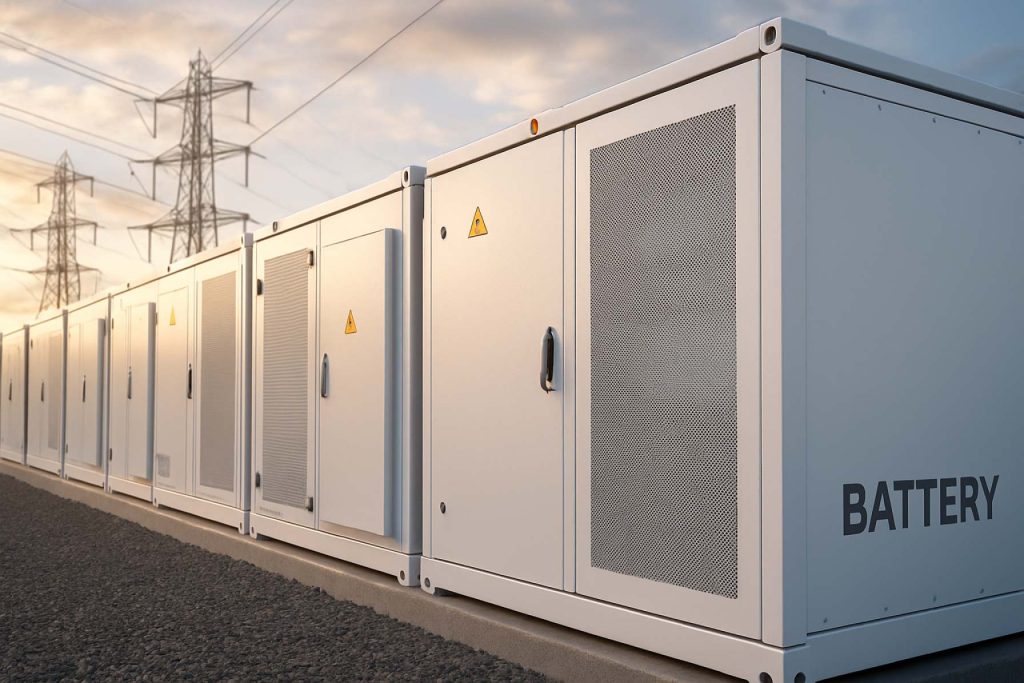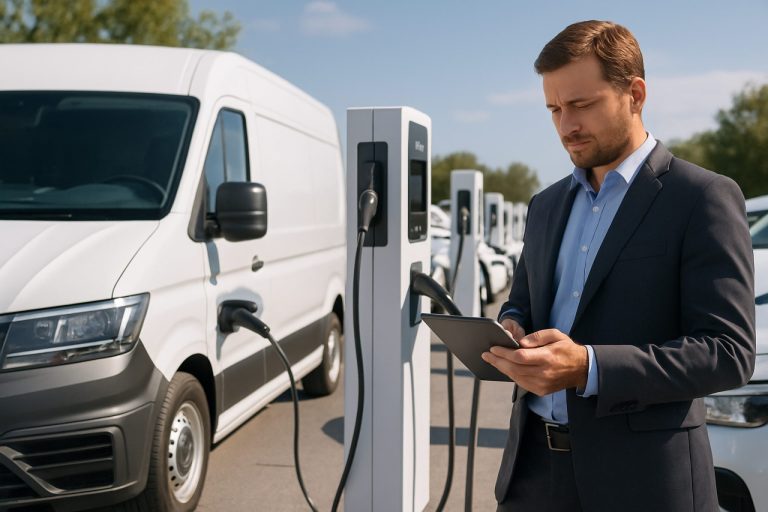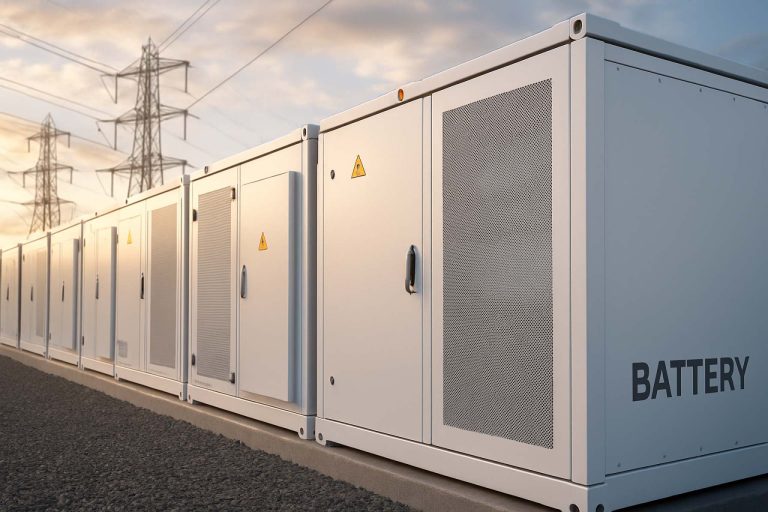
- MegaMAX is a modular battery system that uses repurposed EV battery packs to stabilize electricity grids rapidly during emergencies and fluctuations.
- The system delivers instant synthetic inertia, responding in milliseconds to grid disruptions, replacing the traditional role of coal and gas turbines.
- Combining lithium iron phosphate (LFP) and nickel manganese cobalt (NMC) packs, MegaMAX reduces carbon footprint per unit by over 40% and saves around 100 tons of CO₂e.
- Ultra-fast deployment enables operational readiness in just two minutes, supporting disaster response and critical infrastructure with minimal setup.
- One MAX1000 unit stores 1 MWh—enough to power 1,000 homes for an hour—and helps businesses cut energy bills by up to 50% while participating in energy markets.
- MegaMAX combines advanced AI controls, recycled materials, and weather-resistant design to deliver resilient and clean energy, supporting the global shift from fossil fuels to renewables.
Beneath brisk British skies, engineers peel open an international puzzle: how to keep the lights on as nations race from fossil fuels to renewables. The possible answer rumbles out of a shipping container—a modular battery unit, wired for resilience, smart enough to stabilize the grid in the blink of an eye.
MegaMAX, developed by Allye Energy, looks like an ordinary metal box. Yet inside, repurposed EV battery packs—the kind once steering electric cars down rain-swept roads—live a second, powerful life. These units, dubbed MAX1000 and MAX1500, form the building blocks for the future of energy security.
Speed is their secret weapon. Grid emergencies play out in seconds, but the MegaMAX responds in milliseconds. When storms lash powerlines or when a distant fire collapses a vital substation, this battery system surges into action, injecting or absorbing energy to keep the 50Hz heartbeat of modern power flowing true. In one motion, it performs a task traditionally left to coal and gas turbines: supplying instant “synthetic inertia” and halting dangerous frequency swings.
Yet the innovation doesn’t end there. MegaMAX cleverly fuses up to 18 recycled battery packs of mixed chemistries—both lithium iron phosphate (LFP) and nickel manganese cobalt (NMC). This hybrid approach carves the carbon footprint of each unit by over 40%, sparing roughly 100 tons of CO₂e that would otherwise warm the atmosphere.
Deployment matches the urgency of disaster response. Typical backup systems crawl through hours of installation, but the MAX1000 launches in just two minutes—rolled on or off a truck, ready to shield critical infrastructure or newly electrified factories with a minimum of fuss.
Europe has learned hard lessons in grid vulnerability. Spain and Portugal, in recent blackouts, saw entire regions plunged into darkness within minutes, a stark warning that as fossil “inertia” ebbs, power system stability grows fragile. New solutions like the MegaMAX step into this breach, not only preventing chaos during emergencies but also offering businesses a way to slash energy bills by up to 50% while opening doors to sell power back into a growing flexibility market.
Each MAX1000 unit boasts a capacity of 1 MWh, equivalent to one thousand homes powered for an hour. Weighing over 12 tons but surprisingly compact—measuring about the length of two SUVs—the system runs through biting winters and sweltering summers, weather-sealed and IP54-rated for harsh conditions.
In the tapestry of tomorrow’s electricity, MegaMAX tells a story both practical and hopeful. By combining advanced AI controls, recycled materials, and rapid on-site deployment, it weaves resilience into a world that cannot afford to go dark. Whether the next storm strikes in London, Lisbon, or beyond, the new breed of battery storage stands ready—not just to store energy, but to protect modern life as we know it.
Key takeaway: As global grids shift from fossil fuel inertia to the dynamic pulse of renewables, advanced battery systems like MegaMAX promise not just clean energy, but a tougher, steadier, and more affordable future for all. Discover more about clean energy solutions and global innovations at Bloomberg.
The Battery Revolution: Why Modular Energy Storage Like MegaMAX Will Change Your World (and Wallet!)
The Energy Crisis No One Can Ignore: Why Modular Batteries are the Missing Link
As the world pivots from fossil fuels to renewables, the challenge isn’t just generating enough clean energy—it’s making sure power grids stay stable when the wind doesn’t blow or the sun doesn’t shine. Enter modular, grid-scale battery solutions like MegaMAX, developed by Allye Energy, which leverage repurposed EV batteries and AI-driven management to deliver instant, carbon-cutting backup for 21st-century energy demands.
Additional Facts and In-Depth Insights
Key Features & Specifications
– Hybrid Battery Chemistry: MegaMAX uniquely blends up to 18 recycled lithium iron phosphate (LFP) and nickel manganese cobalt (NMC) EV battery packs. This not only increases performance flexibility but mitigates supply chain issues tied to any single material or chemistry.
– Scalability: Both the MAX1000 (1 MWh) and MAX1500 (1.5 MWh) units are designed to be literally “plug-and-play,” allowing multiple units to be combined for larger installations. This modularity is essential for urban deployments, rural electrification, or disaster response.
– Ultra-Fast Deployment: The MAX1000’s “truck in, plug in, power up” approach allows grid operators or businesses to respond to emergencies or opportunities within two minutes—a major advancement compared to legacy backup systems.
– Weatherproof & Durable: With an IP54 rating, each unit is protected against dust, rain, and harsh temperature swings. Units have been tested to operate in extreme climates.
– Integrated AI Controls: Advanced control algorithms monitor, predict, and automate responses to grid changes—eliminating the need for constant manual intervention, and supporting time-of-use optimization and participation in grid services markets.
Security & Sustainability
– Second-Life Batteries: By giving EV packs a second life, MegaMAX technology diverts potentially hazardous waste from landfills and delays the environmental cost of battery recycling and mining for raw materials.
– CO₂ Footprint Reduction: MegaMAX reduces lifecycle emissions by over 40% per unit compared to systems built with new batteries, equivalent to saving more than 100 tons of CO₂e per deployment.
– Circular Economy Playbook: Leveraging recycled batteries is aligned with the circular economy principles advocated by organizations like the Ellen MacArthur Foundation.
Market Forecasts & Industry Trends
– Market Growth: According to BloombergNEF, global stationary storage capacity is projected to grow fourteenfold by 2030, creating a multi-billion-dollar market. Modular, fast-deploy systems are attracting significant venture capital due to their flexibility and sustainability credentials.
– Policy Drivers: EU Green Deal and US Inflation Reduction Act are introducing incentives, grants, and regulatory streamlining for battery storage, making these systems more affordable and accelerating adoption.
– Grid Decentralization: The trend toward decentralized energy—where factories, business parks, or even neighborhoods own modular battery backups—is expected to accelerate, boosting grid resilience against localized blackouts.
Real-World Use Cases
– Critical Infrastructure Protection: Hospitals, data centers, and water treatment facilities can use MegaMAX units to eliminate downtime during grid failures or cyberattacks.
– Industrial Energy Cost Reduction: Factories can time-shift their energy usage, drawing from MegaMAX during expensive peak hours to save up to 50% on bills while selling surplus power back to the grid in low-demand periods.
– Disaster Response: Emergency services or microgrids can deploy units to restore power within minutes after natural disasters—a critical advantage for areas prone to storms or wildfires.
Reviews & Comparisons
– Pros:
– Fastest deployment in class
– Significant sustainability edge due to upcycled batteries
– Compatible with both AC and DC grid configurations
– Cloud-based AI for autonomous operation
– Cons:
– As with all battery technologies, disposal and eventual recycling require strict environmental management
– Dependent on continued EV battery supply, which could be affected by EV adoption rates and industry trends
– Alternatives: Competing products include Tesla Megapack, Fluence Gridstack, and CATL’s containerized storage, but MegaMAX stands out for its rapidity and exclusive use of recycled batteries.
Pricing Insights
– Cost Structure: While exact pricing is customer-dependent, modular units like MAX1000 typically range from $500,000 to $1 million per MWh installed, including software, connection hardware, and support. This cost is offset by both energy savings and revenue from grid participation—often resulting in a 3-5 year payback period for commercial users.
Controversies & Limitations
– Battery Degradation: Second-life batteries may not match the full longevity of entirely new packs, but research shows they maintain 70-80% of initial capacity, making them viable for stationary grid use for 7-12 years.
– Recycling Challenges: End-of-life management is still a concern. However, new battery recycling firms and regulatory frameworks in the EU and US are rapidly advancing.
Security Risks
– Cybersecurity: As battery systems are connected to grid and business networks, they can be an attack vector. Leading providers employ robust encryption and isolation protocols to mitigate this risk.
Predictions & Recommendations
Expert consensus (International Energy Agency, Bloomberg): Battery storage will play a pivotal role in meeting 2030 and 2050 decarbonization targets. Expect storage to move from grid “backup” to a core component of daily energy management, grid balancing, and revenue generation.
—
Top Pressing Questions (with Answers)
1. Is using recycled EV batteries reliable?
Yes—second-life EV batteries retain enough capacity for stationary use, where energy and power swings are more predictable than in vehicles. They also reduce the environmental toll of mining raw materials for new batteries.
2. Can businesses make money with these systems?
Absolutely. Businesses can lower their energy costs by buying power during cheap periods and using stored energy during peak prices. Many regions also pay businesses to offer “flexibility” or “synthetic inertia” services to the grid.
3. What happens when the batteries reach end of life?
Emerging battery recycling technologies, paired with stricter regulations, will increasingly ensure that the metals and chemicals are safely recovered and reused in new products.
—
How-To: Simple Steps to Deploy MegaMAX for Business Resilience
1. Assess Needs: Evaluate your site for backup power requirements and potential revenue from grid services.
2. Consult Vendors: Contact Allye Energy for site evaluation, cost proposals, and integration options.
3. Plan Integration: Work with utility partners to connect to your existing grid or microgrid.
4. Install & Test: Benefit from rapid deployment—units can be up and running in minutes, not days.
5. Monitor & Optimize: Use provided cloud software to monitor battery health, grid participation, and financial returns.
—
Actionable Recommendations & Quick Tips
– For Business Leaders: Begin evaluating battery storage options now. Early adopters can lock in energy bill savings and become resilience leaders in their industry.
– For Facility Managers: Use modular units as a key part of your disaster preparation strategy, especially in blackout-prone regions.
– For Policymakers: Encourage regulatory frameworks that support second-life batteries and grid flexibility markets.
—
Final Takeaway
The electrified, climate-resilient cities and industries of the future will rely on advanced, modular storage systems. Whether you’re a policy shaper, business leader, or homeowner, understanding solutions like MegaMAX is your shortcut to staying ahead of both energy crises and the clean-tech revolution. For ongoing updates on energy innovation and sustainability, regularly check reputable sources like Bloomberg.



